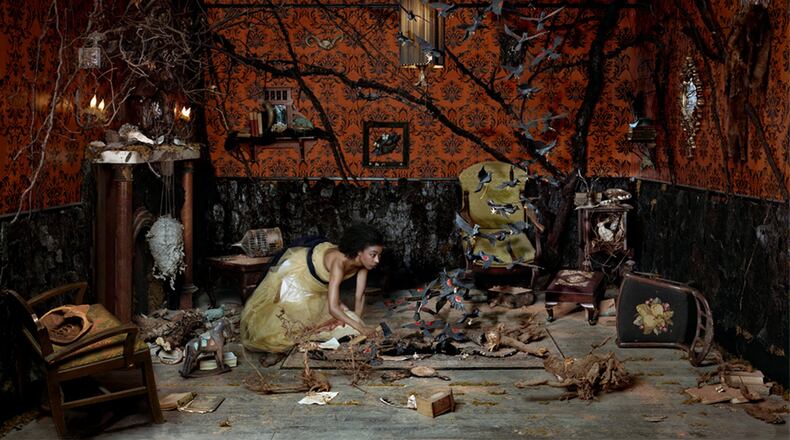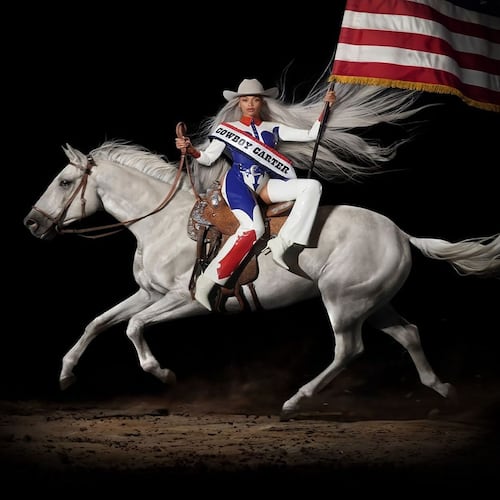For more than a decade Atlanta artist Dorothy O’Connor has created work of delightful specificity and meticulous detail.
O’Connor’s fantastically fussy tableaux, as elaborate as any period-piece film set, are inspired by the historical phenomenon of tableaux vivants, or “living pictures,” featuring actors recreating a scene from literature, art or everyday life and holding their poses for the amusement of an audience.
For “Dorothy O’Connor: Scenes” at the Museum of Contemporary Art of Georgia, O’Connor has assembled 13 works which translate that tableaux vivants concept into photographs. On occasion, O’Connor has also staged these scenes as performances for Flux Night or Atlanta Celebrates Photography, harkening back to that original tableau vivant concept, and then documented the moment with an image.
Though the photographs shown here were taken from 2006 to 2017, O’Connor’s works are remarkable for their consistency. They show a natural world in flux, where strange phenomena are unleashed. Their central performer is a pretty young woman who becomes a participant in that flux — helping move chaos along — or a hapless observer, trapped in the unspooling weirdness. The rooms in O’Connor’s photos are invaded by inexplicable cataclysms like the surreal doings in magical realist novels or the contemporary ennui expressed in the photographs of Jeff Wall and Gregory Crewdson.
In “Tornado” (2011) a woman churns a hand-crank that seems to unleash a swirling black twister in the middle of a living room, scooping up bird cages and toy horses and lamps in its path. In “Underneath” (2009), which has the exotic, otherworldly feel of one of D.W. Griffith’s silent film melodramas, a contemplative woman sits on a bed that appears to float on a lake. Her image, reflected in the water, lays prone on the same bed, a disobedient doppelganger. In addition to being a photographer, O’Connor is an art director, a costume designer and a prop master who often fills her scenes with objects donated by supporters to her Kickstarter campaigns. Her vignettes can take as long as six months to build and it’s clear from these images that the act of creating these fictions is as satisfying for O’Connor, if not more so, than the finished photograph.
Most of the photographs are focused on female labor of some sort and the women suggest doubles for the photographer herself, enacting elaborate dramas for our entertainment. In “Crocheting the Ocean” (2010), a woman whose kinky gray hair echoes the Spanish moss draping the room sits in a papier-mâché boat in the middle of a living room decorated with seafaring oil paintings. She crochets a rich blue ocean afghan that spills out of her boat and onto the floor.
O’Connor’s richly detailed tableaux — like the artful, busy scenes you’d find in New York City department store windows at Christmas — brim with a love of drama, ornamentation and an embrace of the natural world. The photographs are beholden to a kind of Victorian fussiness in their elaborate domestic trappings — ornate wallpaper, overstuffed furniture, bric-a-brac galore — but also to a very specific contemporary hipster milieu of girls with shaved heads and nose-piercings and Manic Panic hair dye, decked out in the kind of frilly ’50s prom dresses you’d pick up at a second-hand store.
Surveying these works as a whole, O’Connor could be accused of often dipping into the same formula with an avidity that can border on repetition. The work is admittedly visually seductive, if occasionally a little hollow once you register certain repeated tropes: birds, floods, storms, books, encroaching nature and lone girls in the center of it all, doing their best to contend with a personal apocalypse.
Art Review
“Dorothy O’Connor: Scenes”
Through Nov. 2. 10 a.m.-5 p.m. Tuesdays-Saturdays. $8 general admission, $5 for students with ID and seniors 65+; free, children 6 years of age and under, members and U.S. military and veterans. Museum of Contemporary Art of Georgia, 75 Bennett Street, Suite A2. 404-367-8700, www.mocaga.org
Bottom line: Charming scenes of domestic chaos and resilient girls define Dorothy O’Connor’s occasionally repetitious photographs.
About the Author
Keep Reading
The Latest
Featured


